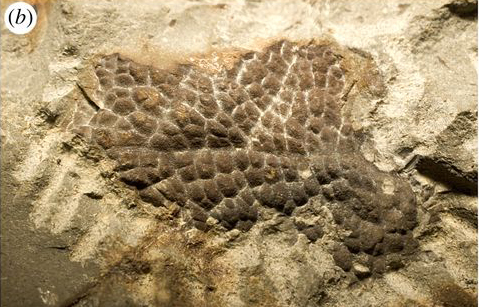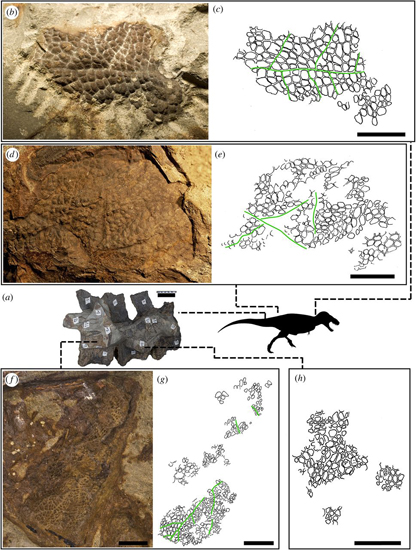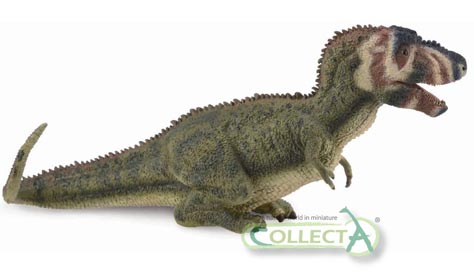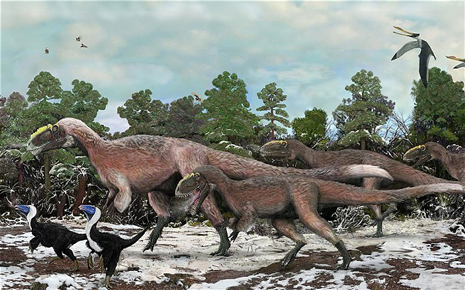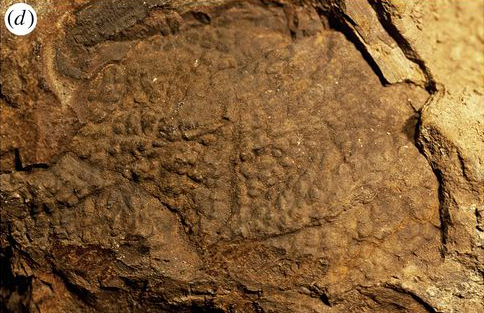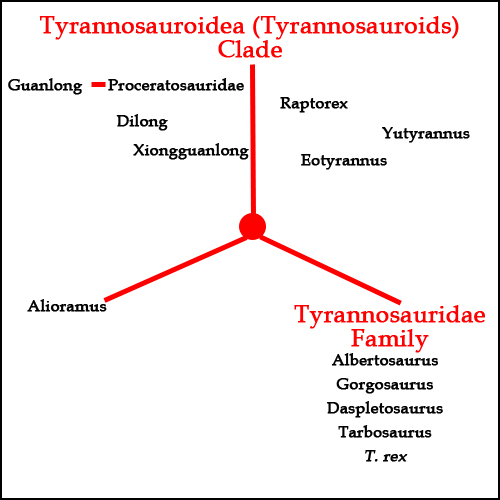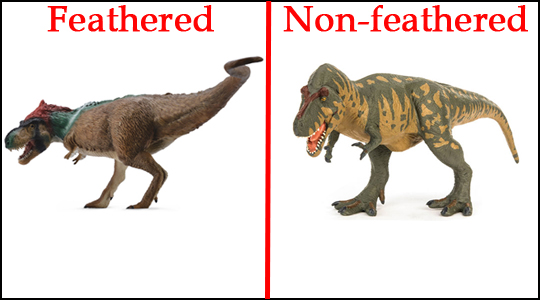T. rex Sheds Its Feathers?
The Scaly Skin of Tyrannosauroids
So, it is published! A team of eminent scientists, some of the leading lights in palaeontology, have published in the Royal Society Biology Letters details of research that questions whether Late Cretaceous tyrannosaurids, including the iconic Tyrannosaurus rex sported a coat of feathers.
Research into T. rex Feathers
At Everything Dinosaur, we have known about the fossils upon which this research is based, for some time. Indeed, we are aware of a number of research projects taking place exploring the evidence for integumentary coverings in the Dinosauria. This new study looks at skin impressions from several Late Cretaceous, giant tyrannosaurs and concludes that despite early tyrannosauroids having feathers, T. rex and its near relatives, most likely had scaly skin.
A Fluffy, Feather Covered Tyrannosaurus rex
Picture credit: Everything Dinosaur
The image (above) shows the Dino Dana feathered T. rex figure.
To view this range: Wild Safari Prehistoric World.
The research has generated some surprising headlines, looks like many media outlets have got into a bit of a flap:
“Feather furore: T. rex may not have been fluffy after all, skin study suggests” – The Guardian.
“Tyrannosaurus rex had scaly skin: Here are the controversial reasons why scientists think the dinosaur was NOT covered in feathers” – Mail Online
“Jurassic Park may have been right about the T-rex after all” – Silicon Republic
“Here’s what it would feel like to pet a T. Rex” – National Geographic
Some quick points:
- If you publish a story that features Tyrannosaurus rex lots of media outlets are likely to cover it.
- You can expect some sensational headlines.
- Expect numerous faux pas when it comes to the “Tyrant Lizard King” – rapped knuckles for Silicon Republic and National Geographic! No hyphen in T-rex, no capital letter for the trivial name etc.
What Does the Study Show?
The research team led by Dr Phil Bell (University of New England, New South Wales, Australia), examined the fossilised skin impressions associated with a partial skull and postcranial material of a Tyrannosaurus rex specimen “Wyrex” from the Hell Creek Formation of Montana. These fossils are part of the vertebrate fossil collection at the Houston Museum of Natural Science, hence one of the co-authors, Robert T. Bakker’s (curator of palaeontology at the Houston museum), involvement in the study.
The specimen represents around 30% of an entire skeleton, it was excavated from upper Maastrichtian strata near the town of Baker (Montana), in 2003 and it was formerly part of the Black Hills Institute fossil collection (BHI 6230), hence the participation in the study by Pete Larson (Black Hills Institute of Geological Research, South Dakota). The gracile form of the skeleton suggests that “Wyrex” was male.
Preserved Skin Impression on the Neck of “Wyrex”
Picture credit: Biology Letters
“Wyrex” is Special
“Wyrex” is special, as in association with the fossilised bones and teeth, several patches of the integument are preserved as impressions. These impressions represent skin from the neck, the pelvic area and from the tail. The tail skin impressions are the most numerous, but all of them combined do not represent a very large part of the surface area of a T. rex. The patches are very small ranging in size from less than a postage stamp in area to an impression of approximately 30 square centimetres, a tail skin impression that that would have covered less than a third of the screen on an average mobile phone. Although these impressions are very small, any form of integument preservation is remarkable and they have provided an invaluable insight.
Integument of Tyrannosaurus rex (HMNS 2006.1743.01)
Picture credit: Biology Letters
Skin Impressions on Tyrannosaurus rex Fossil
The picture above shows impressions and where they are located on the T. rex (see silhouette). Three bones are shown (a), they are bones from near the base of the tail (caudal vertebrae 6-8) which are associated with skin impressions (f), (g) and (h). Integument from the neck (b, c) and from the ilium (pelvis) in (d, e). The line drawings show the great variation in the size and shape of the scales. The researchers highlight the variety of the scales, some are elliptical, some are elongated, whilst others are irregular six-sided polygons.
Note the scale bars, in a lot of the media coverage, the actual size of the impressions has not been reported, the scale bars in the picture above:
(a) = 10 centimetres, (b-e) = 5 millimetres and (f-h) = 10 millimetres
Not Just Tyrannosaurus rex Skin in the Study
To the north of Montana, lies the Canadian Province of Alberta. Geography lesson over, but noting the location of Montana is significant, as scientists from the University of Alberta and the Royal Tyrrell Museum (also in Alberta), have played a part in this research. Illustrious figures from the world of palaeontology such as Professor Phil Currie and Scott Persons (University of Alberta) and Darren Tanke (Royal Tyrrell Museum). These luminaries along with Nicolás Campione (Uppsala University, Sweden), have helped compile a new data set plotting tyrannosauroid integument against body size.
This study looked at fossil skin impressions from a number of other Late Cretaceous relatives of T. rex, monsters such as Albertosaurus, Gorgosaurus, Daspletosaurus, all from North America, plus Tarbosaurus from Asia.
The Late Cretaceous Daspletosaurus (Fossils found in Montana and Alberta)
Picture credit: Everything Dinosaur
The model (above) is the CollectA Prehistoric Life Daspletosaurus.
To view this model range: CollectA Prehistoric Life Replicas.
Large-bodied Forms had Scaly Skin
The research team conclude that these large-bodied forms possesses scaly, reptilian-like skin. By mapping integument against body size against the tyrannosauroids, a more extensive data set than just the Tyrannosauridae family, the team postulate that large body-size evolved two times in the evolutionary history of this substantial group. Early tyrannosauroids such as Yutyrannus (Y. huali), which was feathered, was part of one branch of the tyrannosauroids that became giants and gigantism occurred again in later tyrannosaurids such as T. rex, Gorgosaurus, Albertosaurus et al.
The data suggests that shaggy, feathery coats as found in some early tyrannosauroids, were lost by the Albian faunal stage (around 112 million years ago). Later tyrannosaurs, those that were the ancestors of the very last members of the Tyrannosauridae to evolve, did not have feathery coats.
Yutyrannus Roamed Northern China 125 Million Years Ago
Picture credit: Brian Choo
To read an article about the discovery of Yutyrannus huali: One Tonne Feathered Tyrannosaur.
Yutyrannus – A Tyrannosaur Game Changer
The discovery of a large (up to nine metres long and weighing 1.4 Tonnes), tyrannosaur provided evidence that giant theropods could have been covered in a shaggy coat. Prior to the description of Y. huali (the name means beautiful feathered tyrant), back in 2012, the only tyrannosaurs discovered with proto-feathers were much smaller animals, dinosaurs such as Dilong, (D. paradoxus), which also roamed China. It had been thought that smaller tyrannosaurs, with their warm-blooded metabolisms evolved feathers to help keep their bodies insulated. However, here was a much larger dinosaur, one that was also covered in feathers.
In this new research, the scientists conclude that the environment that Late Cretaceous giants such as Albertosaurus and T. rex lived in had a similar climate to the environment that Yutyrannus lived in millions of years before. They discount the idea that the big Late Cretaceous tyrannosaurs had feathers to keep them warm. The larger the animal, the smaller the surface area compared to their volume and therefore big creatures tend to be better at retaining heat than smaller ones. In the paper, it is argued that a big, thick coat of feathers may have been a real hindrance to a Tyrannosaurus rex, as its active lifestyle could have given it serious problems with over-heating.
A Close View of the Skin Impression over the Pelvic Area (Ilium) of T. rex
Picture credit: Biology Letters
Tyrannosauroid versus Tyrannosauridae
The assessment of these scale impressions along with the analysis of tyrannosauroid integument against body size does not necessarily mean that T. rex was definitely covered in scaly skin. This new research may cast doubt on the idea of an adult, Late Cretaceous tyrannosaur looking like a giant chicken, but it is important to note that the researchers comment that dinosaurs such as Albertosaurus, Gorgosaurus and T. rex may have had feathers on those parts of the their body which are not represented by skin impressions in the fossil record – on their backs, or around the top of the head for example, hence the partially feathered Tyrannosaurus rex image featured in this article.
As juveniles, having an insulating covering of downy feathers does make anatomical sense. The idea that members of the Tyrannosauridae may have had feathers at some stage of their lives cannot be discounted in the same way as that stating that T. rex may have had feathers on some parts of the body cannot be discounted as we lack the fossil evidence to disprove this statement.
The scientists do state that whilst more basal members of the Tyrannosauroidea may have had feathers, later more derived tyrannosaurs, those animals within the family Tyrannosauridae probably did not. The key word to note is “probably”.
Let’s quickly explain what this means.
An Ancient Lineage of Dinosaurs
The tyrannosaurs are a very ancient lineage of dinosaurs, they evolved in the Jurassic and persisted right up until the Cretaceous mass extinction event. The clade Tyrannosauroidea represents the family Tyrannosauridae, to which Albertosaurus, Tarbosaurus, Gorgosaurus, Daspletosaurus and T. rex are part, along with more basal, earlier tyrannosaurs.
Tyrannosauroids and Tyrannosauridae Explained
Picture credit: Everything Dinosaur
In the simplified diagram above, the Tyrannosauridae family is shown as being a part of the larger Tyrannosauroidea clade. Some well-known examples of the Tyrannosauroidea clade as well as members of the Tyrannosauridae family are listed.
The Preservation Factor
Only in very exceptional circumstances can delicate feathers and proto-feathers be preserved. Tough skin has a better preservation potential than filamentous feathers that formed a shaggy coat. Feathers could have been present in members of the Tyrannosauridae, but they simply have not been preserved, so we have no evidence of their existence. Experiments revealing how the corpses of birds decay may help palaeontologists to better understand what happens to feathers after death and their likelihood of being preserved.
Conclusions
In what is a thought provoking and well-argued piece, the scientists comment that their findings reveal significant changes within the integument of tyrannosauroids, especially when compared to skin impressions of later members of the Tyrannosauridae. These changes in body coverings require better understanding and further evidence to help palaeontologists to explain them. The unambiguous loss of extensive body coverings in the Tyrannosauridae merits further discussion.
To mark the publication of the Biology Letters article, we cooked chicken. We left the skin on and from the picture below, you can see the skin but there are no signs of the feathers that would have covered parts of the bird. We suspect that this debate over the appearance of more derived tyrannosaurs is going to rumble on.
Commemorating the Publication with a Chicken Dish
Picture credit: Everything Dinosaur
Which Do You Prefer Feathered or Non-Feathered?
The scientific paper: “Tyrannosauroid Integument Reveals Conflicting Patterns of Gigantism and Feather Evolution”, by Phil R. Bell, Nicolás E. Campione, W. Scott Persons, Philip J. Currie, Peter L. Larson, Darren H. Tanke, Robert T. Bakker published in the Royal Society Biology Letters.
Visit the Everything Dinosaur website: Everything Dinosaur.



